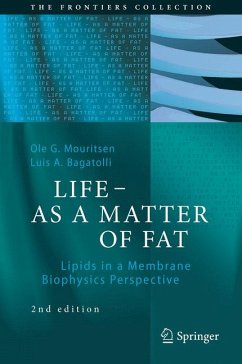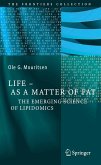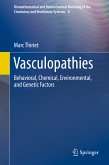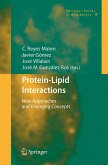The first edition of the present book was published in 2005 when lipidomics was still very much an emerging science and lipids about to be recognized as being as important for life as proteins, sugars, and genes. This significantly expanded and revised edition takes into account the tremendous amount of knowledge gained over the past decade. In addition, the book now includes more tutorial material on the biochemistry of lipids and the principles of lipid self-assembly.
The book is aimed at undergraduate students and young research workers within physics, chemistry, biochemistry, molecular biology, nutrition, as well as pharmaceutical and biomedical sciences.
From the reviews of the first
edition:
"This is a highly interesting book and a pleasure to read. It represents a new and excellent pedagogical introduction to the field of lipids and the biophysics of biological membranes. I reckon that physicists and chemists as well as biologists will benefit from this approach to the field and Mouritsen shows a deep insight into the physical chemistry of lipids." (Göran Lindblom, Chemistry and Physics of Lipids 2005, vol. 135, page 105-106)
"The book takes the reader on an exciting journey through the lipid world, and Mouritsen attracts the attention with a lively style of writing ... . a comprehensive view of the 'lipid sea' can be easily achieved, gaining the right perspectives for envisaging future developments in the nascent field of lipidomics." (Carla Ferreri, ChemBioChem, Vol. 6 (8), 2005)
Dieser Download kann aus rechtlichen Gründen nur mit Rechnungsadresse in A, B, BG, CY, CZ, D, DK, EW, E, FIN, F, GR, HR, H, IRL, I, LT, L, LR, M, NL, PL, P, R, S, SLO, SK ausgeliefert werden.
Hinweis: Dieser Artikel kann nur an eine deutsche Lieferadresse ausgeliefert werden.
"The book takes the reader on an exciting journey through the lipid world, and Mouritsen attracts the attention with a lively style of writing, and attitude to worldplay, as indicated in the book's title." (ChemBioChem 2005, 6, page 1463-1464)
"This is a highly interesting book and a pleasure to read. It represents a new and excellent pedagogical introduction to the field of lipids and the biophysics of biological membranes. I reckon that physicists and chemists as well as biologists will benefit from this approach to the field and Mouritsen shows a deep insight into the physical chemistry of lipids." (Göran Lindblom, Chemistry and Physics of Lipids 2005, vol. 135, page 105-106)
"This book is very much about many different aspects of the physical biochemistry of lipids. It covers the field in a very user friendly manner ... . Each chapter has a variety of useful diagrams and schematics illustrating the key points of the chapter. ... This book would make a useful contribution to libraries in universities and should be seen as essential reading for graduate students working in any aspect of cell biology, nutrition, and applied chemistry." (Andrew Sinclair, Chemistry in Australia, June, 2005)
"The book takes the reader on an exciting journey through the lipid world, and Mouritsen attracts the attention with a lively style of writing ... . a comprehensive view of the 'lipid sea' can be easily achieved, gaining the right perspectives for envisaging future developments in the nascent field of lipidomics." (Carla Ferreri, ChemBioChem, Vol. 6 (8), 2005)
"This is a highly interesting book and a pleasure to read. It represents a new and excellent pedagogical introduction to the field of lipids and the biophysics of biological membranes. ... I would like to highly recommend this book ... . an introductory textbook for graduate or advanced undergraduate students in biology, chemistry and physics as wellas a lovely complementary text in a course of colloid chemistry." (Göran Lindblom, Chemistry and Physics of Lipids, Vol. 135, 2005)
"This book presents a multidisciplinary perspective on the physics of life, and particularly, the role played by lipids and the lipid-bilayer component of cell membranes. ... This valuable and interesting book about the emerging science of lipidomics is aimed at undergraduate students and young research workers within physics, chemistry, biochemistry, molecular biology, nutrition, as well as pharmaceutical and biomedical sciences." (Advances in Food Sciences, Vol. 28 (2), 2006)









